Market Trends & Data
Market News & Data
General Info
Real Estate Strategies

Landlording & Rental Properties
Real Estate Professionals
Financial, Tax, & Legal


Real Estate Classifieds
Reviews & Feedback
Updated 10 months ago,
- Real Estate Broker
- Greater Charlotte NC and Charleston, SC areas
- 54
- Votes |
- 96
- Posts
Nationwide Housing Stats - And Expected rate Reductions plus Modest Housing Gains
Weekend Talking Points – ‘Sunshine’
for Saturday, April 6, 2024
Here’s my weekly briefing on all things real estate. Feel free to share: better-informed agents and LOs provide more valuable counsel to their Investor clients!
Real Estate News in Brief
Will stubbornly high mortgage rates hurt the spring selling season for the second straight year? Not necessarily. The latest new and existing home sales data suggest that buyers are taking advantage of increased inventory — and in some markets, lower prices — to act on purchases that they may have deferred for several years.
Price growth surprises. After two months of slight (0.1% MoM) decreases, CoreLogic’s national Home Price Index jumped 0.7% MoM in Feb, way above their expectations. CoreLogic now expects 3.1% price growth over the next 12 months. A few months ago, that was 2.5%. [CoreLogic]

National inventory continues to rise. According to Realtor.com’s residential listing database, active inventory in March 2024 rose 4.5% MoM to 695,000 units (that’s up 23.5% YoY!) New listings, meanwhile, jumped 16.6% MoM and were up 15.5% YoY. More properties for sale = more properties sold.
Fed speakers galore. Since the March 31 FOMC meeting, there has been an incessant flow of Fedspeak from various public engagements. Most Fed members have just been repeating the “party line”: inflation is declining, but there’s “no rush” to cut rates with the economy and jobs market so strong.
The jobs data didn’t help mortgage rates
Nothing shocking from JOLTs. The February JOLTs report (Job Openings & Labor Turnover) showed job openings were steady month-over-month at 8.7–8.8 million. While that was down 11% year-over-year (from 9.8 million in February 2023), there were no clear signs that the labor market was loosening up significantly. [BLS]
But several shocking things from ADP. ADP’s latest employment report showed that the US economy added 184,000 jobs in March, well above expectations. In addition, the figure for February was revised up from +136,000 to +155,000. While the average annual wage increase for job “stayers” was stable at 5.1% in March, the wage increase for job “changers” leapt from +7.6% YoY in February to +10.0% YoY in March — an unprecedented (and inexplicable?) monthly increase. [ADP]
Not a good omen for BLS data out on Friday. The market is currently expecting to see +200,000 jobs in March (and a 3.9% unemployment rate) from the BLS jobs report. As a reminder, the February BLS report delivered a shocking +275,000 jobs. Will that February figure get revised down? Will the market care if it does? [BLS]
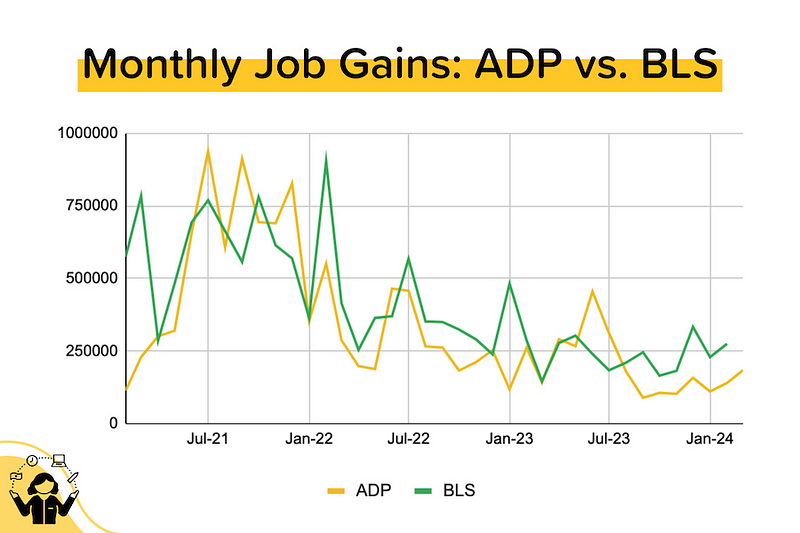 Let’s Focus on Florida
Let’s Focus on Florida
Even if you’re not from Florida, you need to pay attention to what’s happening in the Sunshine State. Why? Because Florida is the nation’s largest contributor to active inventory (19%) and monthly new listings (15%), despite being the 3rd-most populous state.
Florida Facts:
Population: 23 million (#3 after CA with 39 million and TX with 30 million)
Active Listings (Feb 2024): 125,962 (19.0% of total US active listings)
New Listings (in Feb 2024): 49,294 (14.6% of total US new listings)
Median Listing Price (Feb 2024): US$459K
Increase in Median Listing Price (YoY)
2017: +6.6%
2018: +0.1%
2019: +3.1%
2020: +3.7%
2021: +21.1%
2022: +8.5%
2023: +2.2%
Median Listing Price: Florida
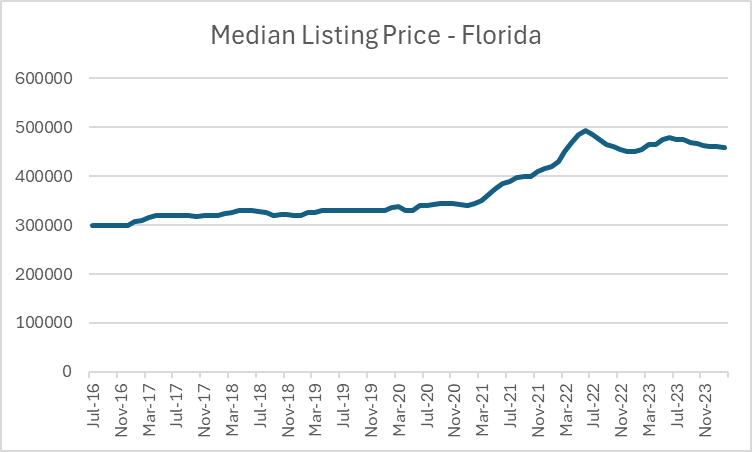
Active Inventory: Florida
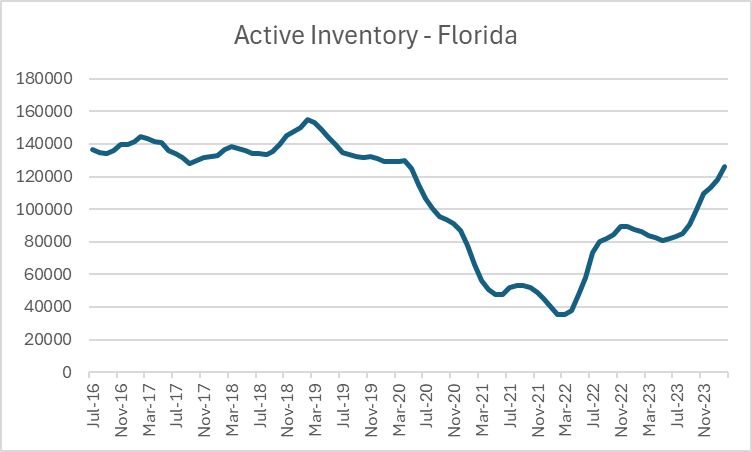
At the state level
Florida’s active inventory of nearly 126,000 listings is back to pre-pandemic levels. This has important implications for pricing. Prior to the pandemic, Florida’s price appreciation was fairly modest (as measured by the median listing price, which is far from perfect). But during the pandemic, Florida prices shot up: big cities like Tampa and Miami saw ~60% appreciation, leading the nation.
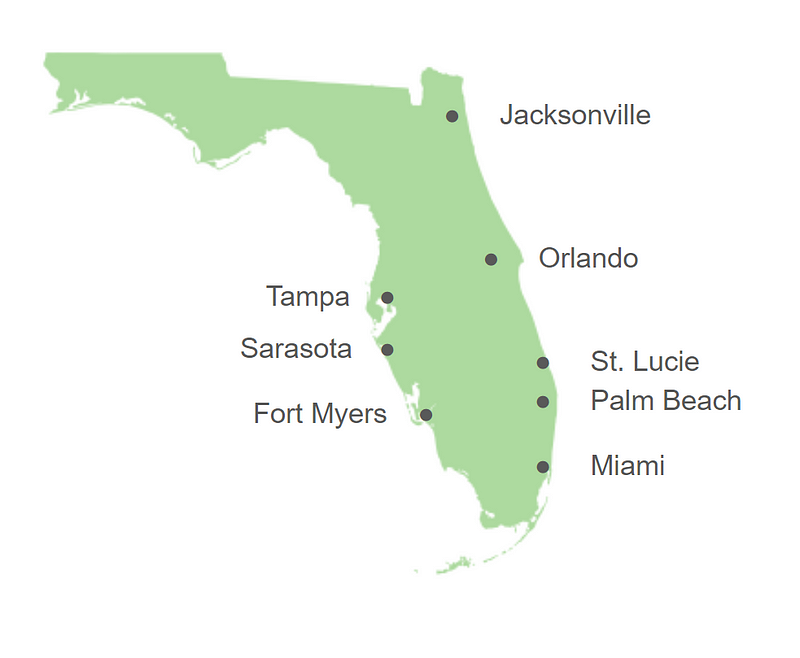
But let’s look a little closer
I used Realtor.com’s residential listing database to look at inventory and listing prices for Florida’s 8-largest metros, which together account for nearly 70% of the state’s active inventory. I found all 8 of these metros had current listing prices that were below their mid-2022 peak. (Part of this is seasonal, some of these are likely to close as the spring selling season kicks in.) I also found that 5 of the 8 had active inventory that was ABOVE their end-2019 (pre-pandemic) levels. (And another one, Orlando, was very close.)
Look at North Port-Sarasota and Cape Coral-Fort Myers: active inventory is ~20% above pre-pandemic levels and prices rose >60% during the pandemic. Even with strong net migration, it’s going to be difficult for these markets to hold prices.
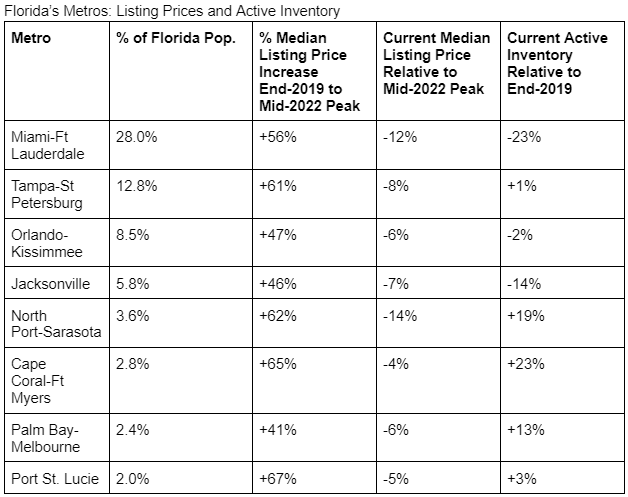 Mortgage Market
Mortgage Market
Last week, markets were sleepy. This week (jobs week), markets have been volatile.
Negative news (tending to make bond prices fall; bond yields and mortgage rates rise):
- A stronger than expected employment report from ADP, including an apparent reacceleration in wage growth for job changers.
- Commentary from Fed members Raphael Bostic, Loretta Mester, and Neel Kashkari suggesting that there was “no rush” to cut rates unless unemployment rates began to spike.
Positive news (tending to make bond prices rise; bond yields and mortgage rates fall):
- Fed Chairman Jerome Powell saying that — despite the recent “bump” in inflation — rate cuts were still likely this year.
- Weekly jobless claims came out at 221,000 for the week ending March 30, a bit higher than expectations.
As always, everything could change today (Friday) with the release of the BLS jobs report for February. Of particular interest will be the revisions (if any) to the January report, which blew expectations out of the water and helped send average mortgage rates back above 7%.
Current odds on Fed rate cuts at upcoming FOMC meetings:
- May 1: 7% (up from 4% last week)
- Jun 12: 69% (up from 64% last week)
- July 31: 82% (from 78% last week)
Note: These probabilities (which come from CME Group) are implied from the real-time prices of different Fed Funds futures contracts. They tell you what the market is “pricing in” in terms of rate cuts. So the market is only pricing in a tiny chance of rate cut on May 1, but is pricing in a high likelihood of a rate cut by July 31.
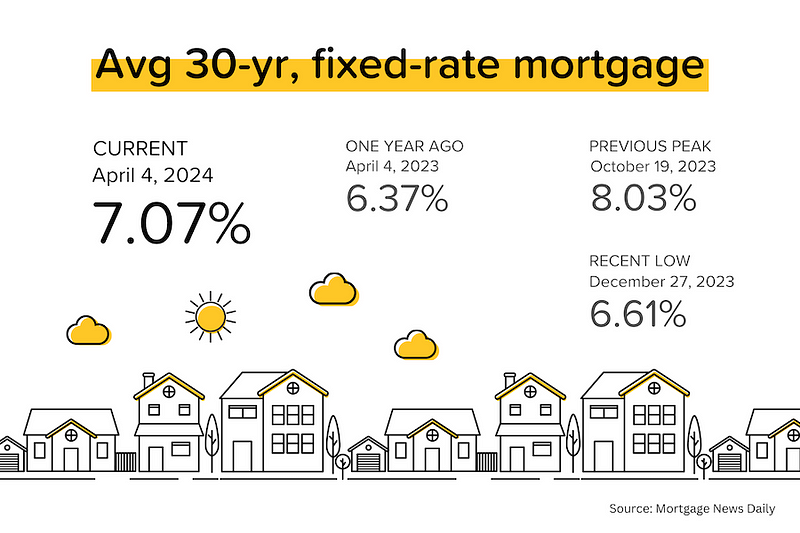 They Said It
They Said It
“With a 0.7% increase from January to February 2024, which is almost double the monthly increase recorded before the pandemic, spring home price gains are already off to a strong start despite continued mortgage rate volatility. That said, more inventory finally coming to market will likely translate to more options for buyers and fewer bidding wars, which typically keeps outsized price growth in check. Still, despite affordability challenges, homebuyer demand appears to favor already expensive, coastal markets with a limited availability of properties for sale.” Dr. Selma Hepp, Chief Economist for CoreLogic
- Kristen Haynes
